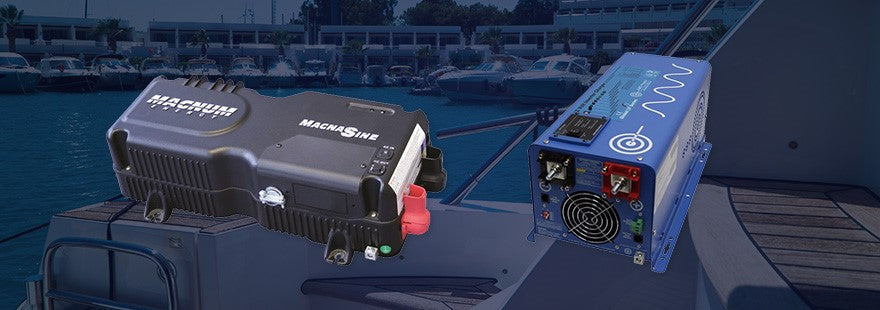Upgrading your boat or RV’s inverter system is a great way to boost your power capacity and make life a little easier when away from home. But will an inverter and a separate charger suffice, or do you need an all-in-one inverter charger system?
Today, we’re exploring the difference between an all-in-one inverter charger and a standalone inverter and charger. You’ll then have a better idea of what will work best for you and your family’s needs.
Standalone Inverter
The most common type of power inverter is a standalone inverter. It works by taking DC power from the battery and then inverting it to AC power—your standard household-type electricity. This is the only function of an inverter. But if you just plan to use it to power a single appliance or outlet, this option is often the easiest in terms of installation.
Nice and portable, standalone inverters (like our popular Victron inverters) are typically smaller than inverter chargers and can range in size from 75 watts to nearly 5,000 watts. Determining which size is right for you will depend on your power needs.
Note that by having a standalone inverter and charger, you’ll save money if anything ever goes wrong with either as you’ll only have to replace that one part of the system. However, an inverter only allows you to use as much power as is stored in your battery.
Combination Inverter Charger
An inverter charger, on the other hand, is an inverter, transfer relay and converter/charger built into one handy device. It offers the ultimate in camper convenience.
A boat or RV inverter charger features an internal transfer switch that automatically detects when you’re hooked up to another power source (like shore power). It then transfers any power load to the new AC power source and uses that source to start charging the battery. Without this feature, you’d have to manually switch a transfer switch or unplug appliances and reconnect them to the new power source. When unplugged, the charger will shut down and the transfer relay will revert back to inverter power. In simpler terms: A combination inverter charger allows for more surge power, which is necessary for starting most appliances.
This type of inverter typically also comes with a remote panel that allows you to monitor your overall usage and battery level. You can then customize your settings based on your battery type and more, which helps to extend your battery life.
Inverter chargers are usually available in sizes above 1,000 watts. While they are incredibly convenient, that convenience does not come cheap. Inverter chargers are generally more expensive than standalone models and will require installation costs. Note that an RV or marine inverter charger should be installed by a licensed electrician or certified installer.
Which Option Is Right for You?
Now that you understand the difference between a standalone inverter and an inverter charger, you should have a better idea of which is right for you and your family. Consider your application and how you use your RV or boat.
If you need to power a single appliance or like to vacation or live off the gird, a standalone inverter might be the right choice for you. If you need to power more than once appliance on your boat or RV, or you use full hook-ups every night, an inverter charger may be the way to go.
Shop Inverter Chargers, Batteries and More at Boat & RV Accessories
At Boat & RV Accessories, we have everything you need to take your home away from home to the next level. Shop for RV inverters, Victron Energy battery supplies, RV transfer switches and more. Have a question about your boat or RV needs? Contact us today.

